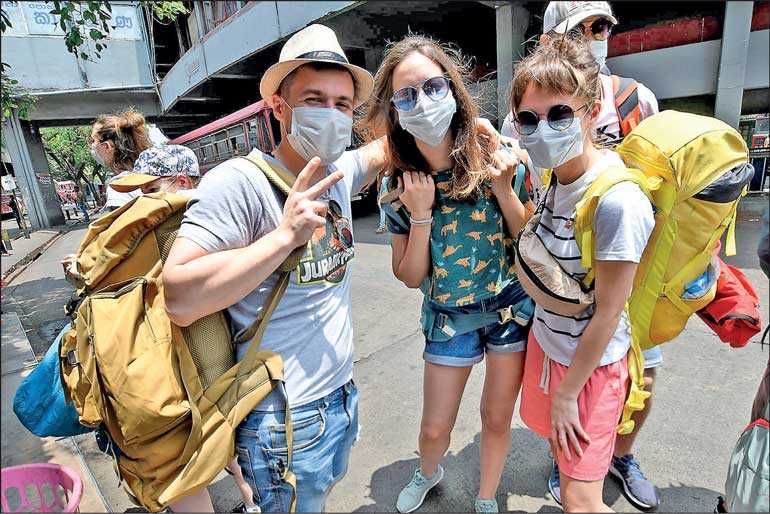Friday Apr 04, 2025
Friday Apr 04, 2025
Friday, 22 May 2020 00:18 - - {{hitsCtrl.values.hits}}

We consider the US a well off and prosperous economy. And being the world’s largest economy, that is objectively the case in many ways. But lest we think the COVID-19 ‘reaction’ related suffering (as opposed to that flowing from the virus itself) is congregated only in developing countries, read the  following and see if it resonates:
following and see if it resonates:
“Thank you so much for writing this! I have been so angry for weeks. I am a flight attendant that is likely out of work permanently. I have been doing my job for so long the thought of changing careers this late in life is daunting, but with so few flights and with all airlines effectively grounded I know that there is no going back for me. I’ve been told I’ll have pay for a few more months but then I’m going to have to start drawing from my retirement account. It hurts so much after saving all these years. As tragic as the deaths from COVID are what am I supposed to do? Do I go to work in a grocery store now? Go work in an Amazon warehouse? Do people understand what it is like to lose your life overnight? The people who are saying we need to stay locked down until this virus is destroyed don’t understand what it’s like to have someone say your job is never coming back. It’s devastating! I’m so angry! I have spent over 20 years being around people and their germs. I understand the risks. I’d rather work than just give up. But it doesn’t matter because with these lockdowns the airline I work for will probably end up bankrupt.”
Now, the impact is magnified in places where the issue isn’t even demolition of ‘savings’ but literal starvation, or other medical catastrophes (vaccinations deferred, treatments not undertaken, check-ups that proactively locate life-ending illnesses early being tragically postponed), but we can empathise with the sense of powerlessness, hopelessness and anguish expressed above.
It is to this woman and millions like her, wage earners here, those who work for SMEs that are not in the business of delivering essential items (who have therefore happily been able to earn), or running mobile networks that become that much more crucial when mobility is lost, that we must turn to and respond to.
Most countries have the following “hymn sheet” re returning to increasing normalcy. And so, let’s examine what we now know about each as potential guidance for us here in Lanka.
The testing fascination
Since we are now told by WHO as well as countless epidemiologists and virologists that we are unlikely to ‘eradicate’ COVID-19, then we have to have a jumping off point. Leaders have to define it and make the case for it.
Next, how accurate are our tests? So, let’s say you have a test that is 95% accurate in terms of identifying those who do and don’t have the virus (fairly standard among the better tests), and we test 100,000.
Let’s suppose, taking an example, 1,000 have the virus, that means we will miss 50 of those infected. There would also be a false detection percentage using the 95% accuracy figure, roughly 1 in 20. If so, the test would tell us there are 5,900 people with the virus, rather than the 1,000 who actually have it, in our example here.
So, we can test to get a sense and a range, but this is hardly ‘hard science’, except for a very small minority of tests which we are told are yet to give a false positive, but which are far from in widespread use.
The ‘R’ Factor
There is increasing criticism about reliance upon ‘R’ or the alleged transmission rate. The practicality of ‘defining’ a case, the timeliness of data, the ability to accurately surveil and detect, all these can skew this read-out considerably.
Statisticians also warn us that correlation is not causation. And to have something indefinite be a basis for keeping economies in at best a coma, and at worst experiencing necrosis (the potential ‘killing’ rather than just ‘freezing’ of an industry, career or job), as well as ripple effects on our freedoms, education, health, is absurd.
Four different studies of the 2009 swine flu epidemic, for example, give wildly divergent ‘R’ ratings, ranging from 1.12 to 2.5. The Spanish flu, with retroactive data, shows up with a transmission rate anywhere from 1.4 to 2.8!
As a commentator pointed out, if your salary were pegged in this way (using UK references) as being between .6 and 1.0 (the range being asserted by the UK government for COVID currently), then if you had a base salary of GBP 30,000, your salary would range between GBP 22.5k and 37.5k! Hard to plan a life, or even a lifestyle accordingly.
Listening to our medical professionals and the best science
Doctors globally cannot agree on something as simple as the best mix of carbohydrates or fats for a healthy diet, and this is after a half century of competing research papers! Science is always being updated by new evidence; its very nature is that it is shades of grey.
There are ‘facts’ and there are ‘hypotheses’. The boiling temperature of water and soap and water killing coronavirus we can accept as ‘facts’.
In the COVID-19 world, we have serological studies, we have data, we have hard to peg infection and fatality rates, and we are unsure how long COVID-19 has actually been circulating. There are disagreements about whether the infections naturally peak regardless at about the 50-70 day mark and whether ‘lockdowns’ (much less curfews) actually achieve anything, particularly as ‘lockdown’ seems to have been resurrected with no real medical or scientific precedent since the Middle Ages, owing in part to hotly contested assertions during the second Bush Presidency, flowing from a high school paper based on modelling! It was challenged by epidemiologists in real-time, but then ‘evidence’ was perhaps not that White House’s strong suit.
Ergo, there is hardly medical consensus. No ‘randomised’ trial is now retroactively possible, except that we can look at Taiwan and Sweden, as differing approaches to bypassing the orthodoxy. Taiwan did vastly better with no economic shutdown, and Sweden without devastating its economy seems to be comparable or actually even better in terms of results to many other European countries who had lockdown.
Runaway infectiousness
Not quite that either. ‘Exponential’ literally means, doubling virtually every day or every few days. And this was the panic drum being beaten. The COVID-19 infectiousness ‘spikes’ seem far more extreme than flu, though not necessarily so overall in terms of fatalities compared to bad flu pandemics or influenza seasons (yet anyway). But taking three day rolling averages worldwide, a high school junior in math can confirm it is not ‘runaway’ or ‘exponential’ even pre lockdown (UK 7 March to 23 March had 285 deaths, if exponentially growing pre-lockdown, it would have been 65,536 deaths).
Protect the elderly and test those with pre-existing conditions and wash your hands, could well have done the trick(!), looking at real data, particularly re nursing home deaths as a percentage of total fatalities.
The ‘next wave’ dread
If we have not let immune systems out of from cowering inside, there may well be ‘spikes’, and any such ‘spike’ could be nominated as the ‘second wave’. Let it come, and let it get cycled and managed through immune systems, while being more careful with the most vulnerable.
Do we apply any such ‘tests’ re social and economic functioning for bigger killers? Heart-disease, diabetes, TB, hypertension, car fatalities, dengue? Why elevate this to such giddy, delirious, petrified heights?
Imagine the response to the post 9/11 world if people said, “Guarantee there will be no further terrorist attacks ever, or we won’t venture out or run the economy?” In 30+ years of civil war in Sri Lanka, as the President rightly pointed out, nothing like that ever happened. Why undermine the resilience of a resilient country and people indefinitely?
Assumptions posing as facts
With all cases virtually coming from the navy and armed services and their contacts and some from repatriated Lankans from Dubai, etc., anyone still calling Colombo ‘high risk’ and suggesting we are entitled to still partially paralyse about 50% of GDP, has some explaining to do.
If Tokyo, Shanghai, Hong Kong, Ho Chi Minh City, are open and largely functioning, let’s please leave this ‘population density’ bugaboo alone. Yes, let’s be vigilant. Yes, let’s continue to apply some medical prudence. But in Pareto terms, we must shift 80/20 to 80% liberty and 20% prudence now, not the other way around. We are overdue.
Also, we cannot say our unique fascination with curfew is what has kept fatalities so low here. If there are other countries with better results (there are), with no curfew, then clearly we can’t make that case. Some never shut down their economies. We’ve done well, no doubt. Let’s do even better by moving decisively, not incrementally, forward…carefully, but definitely.
Everybody matters
Yes, anyone suffering from COVID-19 matters. But so do those now destitute, those suffering from domestic violence, those whose education has been interrupted, those whose immune systems may collapse from stress and despair, and all those with medical treatment deferred or delayed with consequences that are hard to quantify and extrapolate.
Why do all of these people, and all the families whose livelihoods may be compromised, a generation that may be paying off mounting national debt, why do they matter less?
If other generations took their chances during pandemics and wars and still built societies, now that we know the risks here are so relatively tame, we can hopefully take inspiration from that example.
Onwards!
The rhetoric of ‘The Hammer and the Dance’ has to now be jettisoned. We now need ‘The Dance and the March’. Dance between responses and evidence based, focused isolation and quarantining where necessary, and otherwise increasing normalcy, and a decisive ‘march’ forward towards replenishing national solvency, resilience and economic viability. That, and not cowering under our beds with masks and disinfectants, is what we now need to be rallied to.
What was always proposed as a temporary plan to build up testing and preserve hospital capacity, somehow in too many places, metastasized into near-universal house arrest for multiple months, and at the two-month mark here, still, for some, a ‘parole’ system at best (based on work, necessities, ID card numbers, etc.)
In the West, worker furloughs at hospitals are now leading to a recession in healthcare, in the midst of a medical crisis! Devastation of every economic sector virtually, mass confusion and demoralisation, suspension of liberties, enforced closures of businesses? A short, sharp, surgical, initial intervention ‘maybe’. But we are well beyond those barrier reefs.
This beautiful country, beloved by so many worldwide, awaits an invitation to ‘dance’ and to ‘march’, to celebrate life anew and ensure ever more here can have the livelihoods by which that life becomes more fruitful, viable and rewarding. We await the clarion call from our leaders. Let’s march!